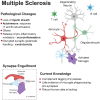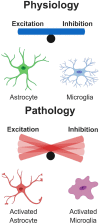Glial Contribution to Excitatory and Inhibitory Synapse Loss in Neurodegeneration
- PMID: 30863284
- PMCID: PMC6399113
- DOI: 10.3389/fncel.2019.00063
Glial Contribution to Excitatory and Inhibitory Synapse Loss in Neurodegeneration
Abstract
Synapse loss is an early feature shared by many neurodegenerative diseases, and it represents the major correlate of cognitive impairment. Recent studies reveal that microglia and astrocytes play a major role in synapse elimination, contributing to network dysfunction associated with neurodegeneration. Excitatory and inhibitory activity can be affected by glia-mediated synapse loss, resulting in imbalanced synaptic transmission and subsequent synaptic dysfunction. Here, we review the recent literature on the contribution of glia to excitatory/inhibitory imbalance, in the context of the most common neurodegenerative disorders. A better understanding of the mechanisms underlying pathological synapse loss will be instrumental to design targeted therapeutic interventions, taking in account the emerging roles of microglia and astrocytes in synapse remodeling.
Keywords: E/I imbalance; astrocytes; microglia; neurodegeneration; synapse loss.
Figures






References
-
- Aggelakopoulou M., Kourepini E., Paschalidis N., Simoes D. C., Kalavrizioti D., Dimisianos N., et al. . (2016). ERβ-dependent direct suppression of human and murine Th17 cells and treatment of established central nervous system autoimmunity by a neurosteroid. J. Immunol. 197, 2598–2609. 10.4049/jimmunol.1601038 - DOI - PubMed
Publication types
LinkOut - more resources
Full Text Sources
Other Literature Sources

